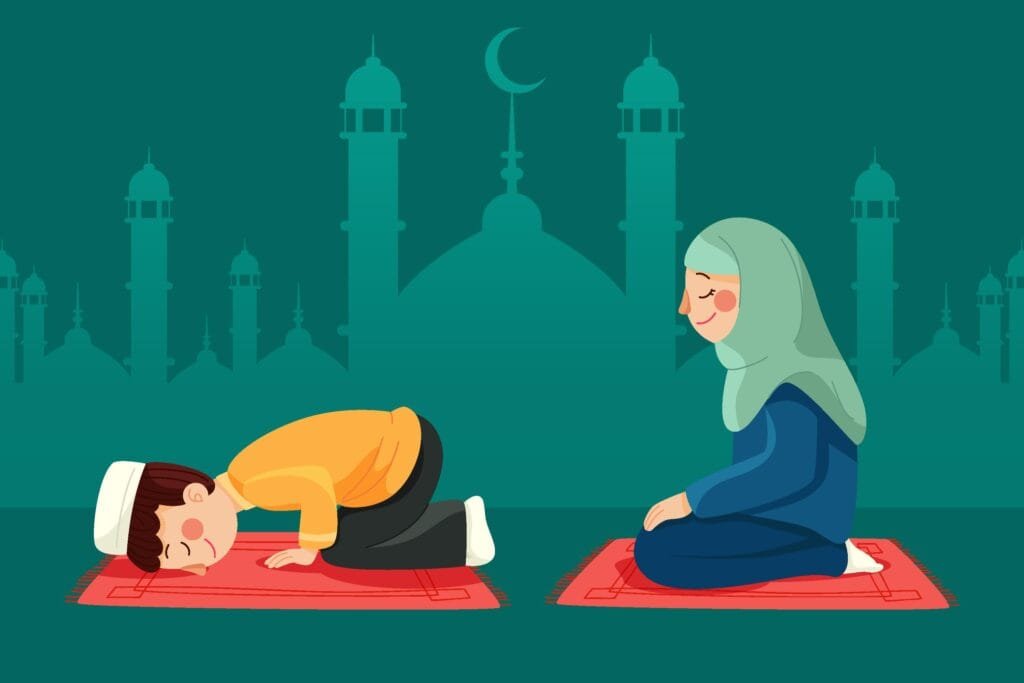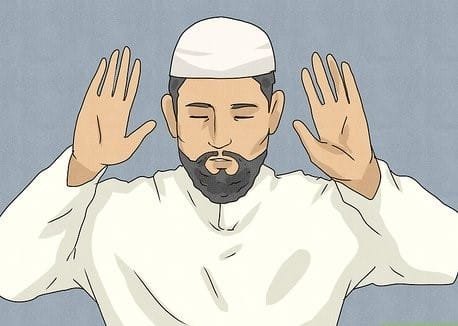Getting Started With The Name Of Almighty Allah
Isha prayer, the final of the five daily prayers in Islam, is a sacred moment for Muslims to reflect, seek forgiveness, and connect with Allah before the night begins. Performed after twilight and before midnight, it holds profound spiritual significance. A common question among Muslims, especially those new to their faith or seeking to deepen their practice, is: “How many rakats are in Isha prayer?” In this blog, we’ll explore the structure of Isha prayer, breaking down its obligatory (Fard), Sunnah, Nafl, and Witr components. We’ll also address key questions like whether Isha consists of 17 rakats or 9 rakats, how many are compulsory, and whether Witr is part of Isha. By understanding these elements, you can enhance your worship and perform Isha with confidence and devotion.
Understanding the 9-Rakat Isha Prayer
For those seeking a balanced yet comprehensive approach to Isha prayer, performing 9-rakat is a common practice. This structure includes both obligatory and recommended rakats, ensuring a fulfilling worship experience. Here’s a detailed breakdown:

Breakdown of the 9 Rakats
- Four (4) Fard Rakats:
These are the mandatory rakats that every Muslim must perform. They form the core of the Isha prayer, and neglecting them invalidates the prayer. The Fard rakats are performed in sets of two, with the first two rakats recited aloud (in congregation) and the last two silently, when offered as a Jamaat (congregation) with an imam leading the group.
- Two (2) Sunnah Rakats:
These are highly recommended (Sunnah Mu’akkadah) rakats that the Prophet Muhammad (peace be upon him) consistently performed. They are prayed after the Fard rakats. Performing these rakats brings additional rewards and strengthens one’s connection to the Sunnah.
- Three (3) Witr Rakats:
Witr prayer is a unique aspect of Isha, often considered Wajib (necessary) by many Islamic scholars. It is performed after the Isha prayer and before the Fajr prayer, usually immediately following Isha. Witr consists of an odd number of rakats, most commonly three. The final rakat of Witr includes a special supplication known as Dua-e-Qunoot, which adds to its spiritual depth.
Significance of the 9-Rakat Isha Prayer
Performing the 9 rakats of Isha prayer that includes 4 Fard, 2 Sunnah, and 3 Witr ensures that one not only fulfills the obligatory duty but also engages in recommended acts of worship. This comprehensive approach to Isha prayer allows Muslims to end their day with devotion and seek Allah’s forgiveness and blessings. The Prophet Muhammad (peace be upon him) emphasized the importance of the Sunnah rakats, including those after Isha, as part of the 12 Sunnah rakats that are highly rewarded. Witr prayer, with its odd-numbered rakats and the inclusion of Dua-e-Qunoot, serves as a powerful conclusion to the day’s worship.
How to Perform the 9-Rakat Isha Prayer

The sequence for performing the 9-rakat Isha prayer is as follows:
- Start with the 4 Fard Rakats:
Make your intention (Niyyah) for the Fard prayer of Isha. Perform the rakats as you would for any obligatory prayer, ensuring to recite Surah Al-Fatiha and another surah (e.g., Surah Al-Ikhlas) in each rakat.
- Follow with the 2 Sunnah Rakats:
After completing the Fard, make your intention for the Sunnah rakats. These can be performed similarly to the Fard, with recitations from the Quran.
- Conclude with the 3 Witr Rakats:
Finally, perform the Witr prayer. For the first two rakats, follow the standard prayer format. In the third rakat, before the Ruku (bowing), make takbeer and recite the Dua-e-Qunoot before proceeding to Sajdah (prostration).
Are There 17 Rakats in Isha Prayer?
The Isha prayer can include up to 17 rakats when Nafl are included, while performing 9 rakats covers all the obligatory and strongly recommended parts. Though, all the 17 rakats are not obligatory and include nafl prayers too, these rakats are categorized as follows:
- 4 Fard (obligatory) Rakats: The mandatory core of the prayer.
- 6 Sunnah Rakats: 4 rakats of Sunnah Ghair Muakkadah before Fard while, 2 rakas of Sunnah after Fard are Sunnah Muakkadah (strongly recommended). Though starting 4 sunnah rakats practice varies slightly across Islamic schools of thought.
- 4 Nafl (voluntary) Rakats: Optional prayers for extra devotion to Almighty Allah, 2 before witr and 2 after witr rakats.
- 3 Witr rakats: Considered Wajib (necessary) by scholars, performed after Isha.
This total of 17 rakats represents the full Isha prayer routine, combining both obligatory and Nafl prayers. However, the exact number may vary depending on individual practice of Nafl prayers or scholarly interpretations, particularly regarding the Sunnah and Nafl rakats.
How Many Rakats Are Compulsory in Isha Prayer?
The compulsory rakats in Isha prayer are:
- 4 Fard rakats: These are mandatory for every Muslim and form the essential part of Isha. Missing them without a valid reason invalidates the prayer.
- 3 Witr rakats: While not strictly Fard, Witr is considered Wajib (necessary) by many Islamic scholars, particularly in the Hanafi school. It is strongly recommended and rarely omitted.
Thus, the total compulsory rakats are 7 (4 Fard + 3 Witr). These form the minimum required to fulfill the Isha prayer obligation. Apart from these, 2 rakats are Sunnah Muakkadah, which are strongly recommended.
Is Witr Prayer Part of Isha?

Witr prayer is closely associated with Isha but is technically a separate prayer and called as “Salatul-Layl”. It is performed after Isha and before the Fajr prayer, often immediately following Isha, which leads many to consider it part of the Isha prayer. Witr consists of 3 rakats and includes a special supplication, Dua-e-Qunoot, in the final rakat. While some scholars debate whether Witr is obligatory or highly recommended, most agree it is Wajib and an essential part of nightly worship. Here you can explore more about “How Many Rakats Are in Isha Prayer?”.
Total Rakats in Isha Prayer: A Detailed Breakdown
To provide clarity, let’s break down the rakats in Isha prayer:
1. Fard (Obligatory) Rakats
- Number: 4
- Description: These are the mandatory rakats that every Muslim must perform. They involve a structured sequence of standing (Qiyam), bowing (Ruku), and prostrations (Sujood), with specific recitations like Surah Al-Fatiha and additional Surahs.
2. Sunnah Rakats
- Number: 6 (4 before and 2 after Fard)
- Description: Sunnah rakats are recommended prayers based on the practice of the Prophet Muhammad (peace be upon him). They are divided into:
- 4 Sunnah Ghair Mu’akkadah (non-confirmed Sunnah) before Fard, which are less emphasized but still beneficial.
- 2 Sunnah Mu’akkadah (confirmed Sunnah) after Fard, which are highly recommended due to the Prophet’s consistent practice.
3. Nafl (Voluntary) Rakats
- Number: 4 (2 before and 2 after Witr)
- Description: Nafl rakats are optional and performed to seek additional closeness to Allah. They are typically offered after the Sunnah rakats and provide an opportunity for extra devotion.
4. Witr Rakats
- Number: 3
- Description: Witr is a unique prayer performed after Isha, often considered Wajib. It is performed in odd numbers (commonly 3 rakats) and includes Dua-e-Qunoot in the final rakat. Witr serves as a spiritual conclusion to the day’s worship.
If you want to explore more about the Witr prayer, see our detailed blog “How To Pray Witr Salah? When To Perform This Prayer?”
| Category | Number of Rakats | Status | Description |
| Fard | 4 | Obligatory | Mandatory core of Isha prayer, performed by all Muslims. |
| Sunnah (Ghair Mu’akkadah) | 4 (before Fard) | Recommended | Optional but beneficial, performed before and after Fard prayers. |
| Sunnah (Mu’akkadah) | 2 (after Fard) | Highly Recommended | Strongly encouraged, based on the Prophet’s consistent practice. |
| Nafl | 2+2 (after the rakats of Sunnah Mu’akkadah and Witr ) | Voluntary | Optional prayers for extra devotion, performed after Sunnah. |
| Witr | 3 | Wajib (Necessary) | Performed after Isha, often considered essential, includes Dua-e-Qunoot. |
Total: 17 Rakats (when all components are included)
The Spiritual Significance of Isha Prayer
Isha prayer is a time to pause, reflect, and seek Allah’s forgiveness after a long day. Performed in the quiet of the night, it offers a moment of tranquility and spiritual renewal. The combination of Fard, Sunnah, Nafl, and Witr rakats allows Muslims to tailor their worship to their level of devotion, making Isha a flexible yet profound act of worship. The prayer reminds us of life’s impermanence and the importance of ending each day in Allah’s remembrance.
Common Mistakes in Isha Prayer and How to Avoid Them
To ensure your Isha prayer is performed correctly, be mindful of these common mistakes:
- Skipping Witr:
Since Witr is considered Wajib by many scholars, neglecting it is a significant omission. Make it a habit to perform Witr after Isha.
- Rushing Through Rakats:
Isha is a time for reflection, so take your time to perform each rakat with focus and humility (khushu).
- Neglecting Sunnah Rakats:
While not obligatory, Sunnah rakats are highly recommended and bring additional blessings. Incorporate them when possible.
- Incorrect Order:
Follow the correct sequence: Sunnah (if performed), Fard, Sunnah Mu’akkadah, Nafl, and Witr.
To perfect your prayers, consider enrolling in Online Quran Classes in USA offered by Najam Academy. These classes provide expert guidance on performing Salah correctly, including the proper method of Witr prayers, ensuring you deepen your understanding and practice with confidence.
Benefits of Performing Sunnah and Nafl Rakats
While Fard rakats fulfill the obligatory requirements, Sunnah and Nafl rakats offer additional spiritual benefits:
- Sunnah Rakats: These prayers emulate the Prophet’s practice, strengthening your connection to his Sunnah and earning extra rewards. Sunnah Mu’akkadah rakats are particularly emphasized for their spiritual value.
- Nafl Rakats: These voluntary prayers allow you to seek Allah’s favor and forgiveness, offering a flexible way to enhance your worship.
Incorporating these rakats into your Isha prayer can transform it into a deeply rewarding experience, both spiritually and emotionally.
Conclusion
Isha prayer is a beautiful blend of obligation and devotion, with up to 17 rakats that include 4 Fard, 6 Sunnah, 4 Nafl, and 3 Witr. While only 7 rakats (Fard and Witr) are compulsory, performing the additional Sunnah and Nafl rakats can enrich your spiritual practice. Witr, though technically separate, is an integral part of the Isha routine, serving as a meaningful conclusion to the day’s worship.
By understanding the structure of the Isha prayer and performing it with sincerity, you can deepen your connection with Allah. For those seeking to refine their prayer technique or learn more about Islamic worship, consider exploring Online Quran Classes in USA at Najam Academy. May Allah accept your prayers and guide you to perform them with devotion and focus. Ameen.




